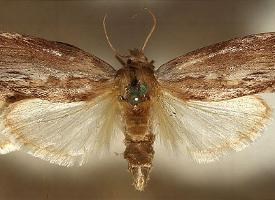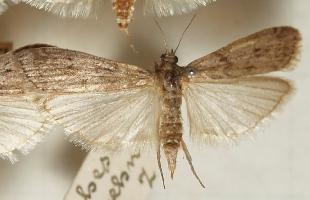
Állatleírás
The Small Magpie (Eurrhypara hortulata) is a captivating species of moth belonging to the family Crambidae. This insect is widely appreciated for its distinctive and striking appearance, which makes it a subject of interest among entomologists and nature enthusiasts alike. With a wingspan that typically ranges between 18 to 25 millimeters, the Small Magpie is a relatively small yet visually intriguing creature.The most notable feature of the Small Magpie is its unique coloration and pattern. The forewings exhibit a fascinating blend of colors, predominantly featuring a creamy-white base color that is beautifully contrasted with patches of dark brown or black. These dark patches are not random; they are intricately patterned and can include spots and streaks that add to the moth's distinctive appearance. The hindwings are usually a more uniform shade of grey or brown, which helps in camouflage when the moth is at rest.
The body of the Small Magpie is slender and covered in fine scales, typical of moths. Its antennae are thread-like and serve as essential sensory organs. The moth's compound eyes are adept at detecting movement and light, which aids in navigation and avoiding predators.
The Small Magpie is a nocturnal creature, primarily active during the night when it embarks on its quest for food and mates. During the day, it prefers to rest among vegetation, relying on its camouflage to stay hidden from predators. The moth is often found in a variety of habitats, including gardens, meadows, and woodlands, where it can find its preferred food sources.
Caterpillars of the Small Magpie are as interesting as the adults, with a diet that mainly consists of herbaceous plants, including nettles (Urtica species). The larvae are known to construct distinctive protective cases out of silk and plant material, in which they live and feed, a behavior that is quite fascinating and adds another layer of interest to the study of this species.
The Small Magpie has a widespread distribution across Europe and extends into parts of Asia, making it a common sight in many regions. Despite its prevalence, the Small Magpie plays a crucial role in the ecosystem, both as a pollinator and as a source of food for predators, thus contributing to the biodiversity of its habitats.
In summary, the Small Magpie (Eurrhypara hortulata) is a small yet remarkably beautiful moth that captivates the attention of those who encounter it. Its unique patterns, nocturnal habits, and interesting life cycle stages make it a fascinating subject for observation and study, highlighting the intricate beauty and complexity of the natural world.
Hasonló állatok
Új állatfotók
Top 10 állat
- Diana monkey (Cercopithecus diana)
- Dolphin gull (Leucophaeus scoresbii)
- Moustached guenon (Cercopithecus cephus)
- Galápagos tortoise (Geochelone nigra complex)
- Stone loach (Barbatula barbatula)
- Japanese spider crab (Macrocheira kaempferi)
- Common house mosquito (Culex pipiens)
- Colossal squid (Mesonychoteuthis hamiltoni)
- Sea urchins (Echinoidea)
- Common reed warbler (Acrocephalus scirpaceus)


